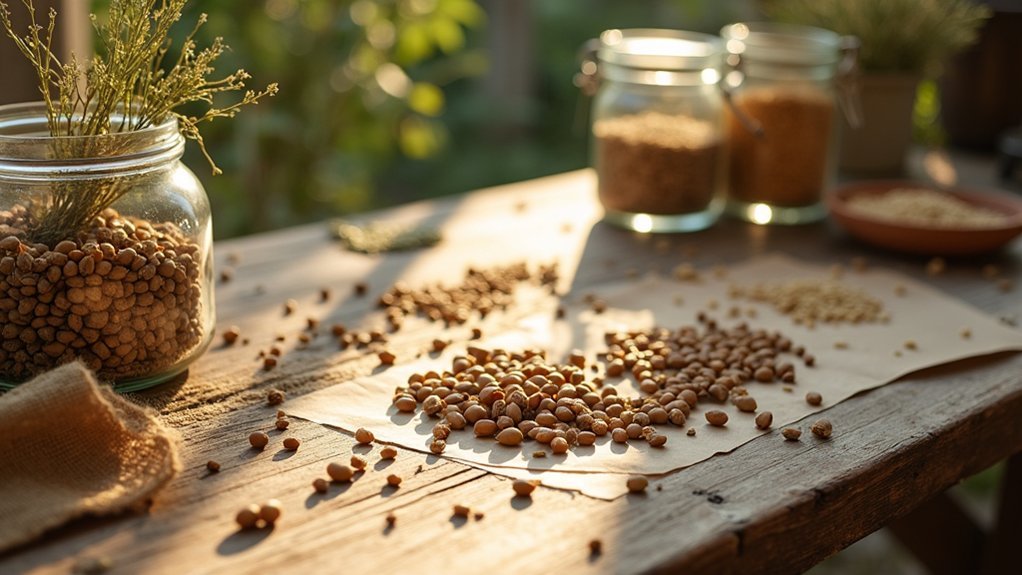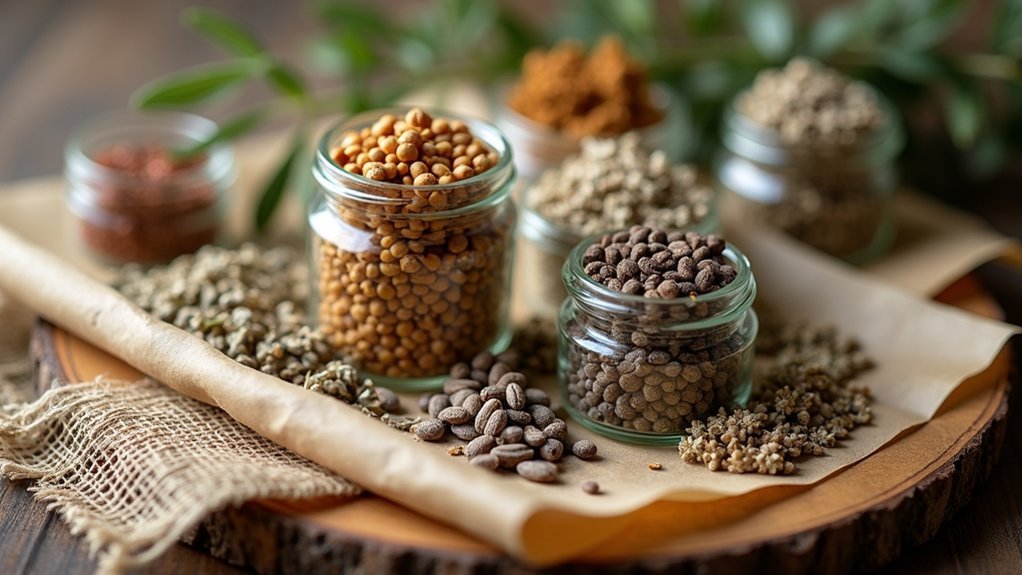To process wild foraged seeds, start by drying them overnight in a well-ventilated area with light covering to prevent moisture buildup. Next, clean the seeds using a metal sieve to remove debris and plant material, gently separating them with a wooden spoon if needed. Finally, store your cleaned seeds in labeled, airtight containers kept in a cool, dark location (32°F-41°F). These three simple steps will transform your woodland treasures into viable growing stock for future planting success.
Drying Your Wild Foraged Seeds For Storage

Once you've collected wild seeds from your foraging expedition, proper drying becomes essential for their long-term viability. After gathering, place your seeds in a dry, airy location overnight. Cover them lightly to allow any hitchhiking insects to escape while preventing moisture buildup that could lead to mold.
Next, use a metal sieve to clean your seeds by removing plant material and debris. This cleaning step is vital for successful seed harvesting and preservation.
When thoroughly dried, transfer your seeds to airtight containers for storage in a cool, dark place that prevents condensation. Don't forget to label each container with the plant species and collection date. This simple organization system helps you track seed varieties and their age, ensuring you'll know exactly what you're planting next season.
Cleaning And Separating Seed Material
Four essential methods make the cleaning process for wild foraged seeds more manageable.
Start by placing your collection in a metal sieve and gently shake to remove chaff and debris. This separates the viable seeds from unwanted plant material.
For seeds with fluffy attachments like milkweed, use a wooden spoon to help with separating them from their fluff.
Once cleaned, allow your seeds to air dry in a well-ventilated space overnight. This vital step eliminates residual moisture that could cause mold during storage.
Finally, store your cleaned seeds in airtight containers like glass jars or sealed bags.
Don't forget to label each container with the plant species and collection date. Proper labeling guarantees you'll know exactly what you've gathered and when to plant them later.
Proper Storage Techniques For Maximum Viability

Three critical factors determine the long-term viability of your wild foraged seeds: temperature, humidity, and container choice.
To guarantee your collected treasures remain viable until planting season, follow these guidelines:
Proper storage transforms wild-harvested potential into tomorrow's thriving garden – patience and protection ensure nature's gifts endure.
- Place seeds in airtight containers like glass jars or sealed plastic bags to shield them from moisture and pests that can quickly destroy viability.
- Store your seed collection in cool, dark locations with temperatures between 32°F-41°F (0°C-5°C) – your refrigerator provides ideal conditions by slowing deterioration.
- Label each container with the plant species and collection date to track seed age and inform future planting decisions.
- Check stored seeds periodically for mold or pest activity, discarding any compromised specimens to prevent contamination spreading throughout your carefully collected bounty.
Frequently Asked Questions
Can I Just Throw Down Wildflower Seeds?
No, you can't just throw down wildflower seeds. You'll need to prepare them properly, plant at correct depths, water appropriately, and monitor for invasive species to guarantee successful germination and growth.
How to Collect Seeds From Wildflowers?
Collect wildflower seeds on dry, sunny days when they're mature and brown. Cut seed heads with sharp scissors, place in labeled containers, and don't take more than 20% from any plant to support natural regeneration.
How Do You Sow Seeds Step by Step?
First, prepare your soil by removing weeds. Then, dig small holes at the recommended depth, place seeds, cover gently, and water thoroughly. Finally, add mulch to retain moisture and check regularly for germination.
Is It Legal to Collect Wildflower Seeds in the US?
Legality varies by state and location. You'll need to check local regulations, as public lands often require permits and national parks typically prohibit collection. Always get permission on private property to avoid legal issues.
In Summary
Now you've mastered the basic steps to process your wild foraged seeds. By properly drying, cleaning, and storing your seeds, you'll guarantee maximum viability for future planting. Don't forget to label your containers with the seed type and collection date. With these techniques, you'll build a sustainable collection of native seeds that connects you to the natural abundance of your local environment.





Leave a Reply